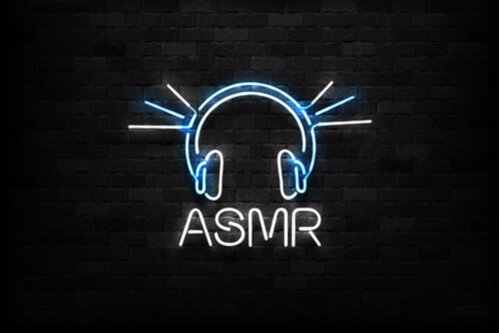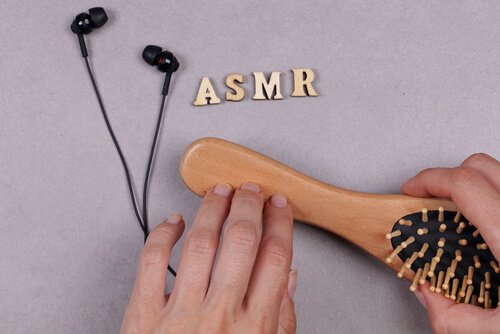ASMR: Pleasure and Relaxation for Certain Lucky People

When I was a child, many times I saw people do certain things that hypnotized me. At that moment, all I could feel was pleasant tingling in my head, and I didn’t know why. Truth is: I liked the experience. With time, I found out that this phenomenon had a name of its own: ASMR (autonomous sensory meridian response) or, weirdly enough, brain orgasms.
A Great Interest in ASMR
Back then, I believed that what I felt was only mine, as indescribable as it was irresistible. In fact, when I asked my friends “Don’t you guys feel like you’re under a spell, but you kind of like it?” Of course, they all laughed at me. Thus, I decided to keep this quirk to myself.
But nowadays, and thanks to social media and how easy it is to spread information, this psycho-physiological phenomenon-that to my surprise and relief, wasn’t exclusive to me anymore-is now known as ASMR.

ASMR interested many people and researchers. More and more people are looking up some kind of ASMR, even if they don’t really know why they feel so good watching it or listening to it. And there’s nothing like finding other people you have this thing in common with.
It’s becoming so popular that there are many YouTube videos, hashtags, blog posts, articles, associations, podcasts, and even scientific studies. What we all know as “brain orgasm” is in fact an undeniable reality with the potential to cause pleasure and treat anxiety.
According to some studies, ASMR is an intrinsic property of many people’s brains, who use it as an easy and therapeutic way of relaxing and feeling pleasant bodily sensations.
What Does ASMR Mean?
ASMR is the acronym of autonomous sensory meridian response. This response is limited to very specific visual or auditory stimuli. Even getting special care or attention can be a trigger, although it’s not as common.
Let’s analyze all the words in the acronym:
- Autonomous. Spontaneous, it happens with or without your control.
- Sensory. A phenomenon related to the senses, to what you feel.
- Meridian. Refers to reaching a climax.
- Response. It’s an experience triggered by an internal or external agent.
Inevitable Tingling and Effortless Relaxation
Let’s start by stating the difference between sexual pleasure and ASMR pleasure, which many describe as a tingling sensation that starts in the neck and expands as a wave of tickles. It manifests and then disappears when the triggering agent comes and goes, respectively.
A The New Yorker article described ASMR as “the shushing sound of voices whispering, or clothes rustling—and then a tingling feeling begins on the scalp, and spreads down into the neck, shoulders, and limbs, and along with it comes a state of calm, or even euphoria”.
Both types of pleasure (sexual and ASMR) are different in nature (in structure and in the physiological processes involved), in the final result (ASMR doesn’t end with a real orgasm), and in their aim (you don’t try to satisfy a sexual impulse through ASMR). In fact, it’s been proven that sexual and ASMR activation are mutually exclusive.
Some Examples
It’s hard for those who have never experienced ASMR to understand what it’s about. Some describe it as a mild electric current that’s both pleasant and relaxing.
In my case, the most accurate definition I could find is this one: “It’s the same thing you would experience if you were in the middle of a bubbly glass of champagne”. Of course, once ASMR triggers, you’re left wishing the sweet numbness would never end.
On the other hand, some examples that can trigger this response are:
- Listening to someone whispering or a voice talking softly.
- Listening to mild repetitive sounds caused by simple daily tasks, like turning the pages of a book.
- Watching someone do an ordinary task.
- Receiving personalized attention.
- Listening to someone chewing loudly, seeing how they bite their food or drink, and appreciating the sounds they make.
- Listening to noises such as nails knocking on plastic, wood, or metal.

ASMR and Medicine
ASMR hasn’t been acknowledged by any official institution, so it’s not a substitute for any treatment. However, more and more people are using ASMR to treat specific problems related to the anxiety disorder spectrum (generalized anxiety, panic attacks, problems focusing on tasks, rumination, and trouble falling asleep, among others).
Its therapeutic effect is similar to that of other techniques such as meditation, yoga, or mindfulness. In fact, just like these practices, the scientific world has already confirmed the benefits of ASMR in terms of physical and mental health.
In fact, according to new scientific findings, several parameters determine the body’s psychophysiological state of relaxation and well-being. ASMR helps to accentuate them.
A Possible Explanation
There isn’t a lot of objective and repeatable data to back up this phenomenon’s origins and mechanisms. But statistics connect people who are prone to liking ASMR and their likeliness to suffer from misophonia (sound sensitivity). That’s why experts on the matter believe it can have a genetic component.
In some studies where fMRI was used, the brain areas of those who claimed to feel a tingling sensation with ASMR, especially the areas related to social behavior or interpersonal relationships (prefrontal cortex), and also those related to touch (secondary somatosensory cortex), were unusually active. And this observed activity was greater than that of the brain without ASMR.
The truth is that people who are lucky enough to enjoy this unusual phenomenon don’t think too much about how or why it works. They simply feel great and that’s all that matters.
When I was a child, many times I saw people do certain things that hypnotized me. At that moment, all I could feel was pleasant tingling in my head, and I didn’t know why. Truth is: I liked the experience. With time, I found out that this phenomenon had a name of its own: ASMR (autonomous sensory meridian response) or, weirdly enough, brain orgasms.
A Great Interest in ASMR
Back then, I believed that what I felt was only mine, as indescribable as it was irresistible. In fact, when I asked my friends “Don’t you guys feel like you’re under a spell, but you kind of like it?” Of course, they all laughed at me. Thus, I decided to keep this quirk to myself.
But nowadays, and thanks to social media and how easy it is to spread information, this psycho-physiological phenomenon-that to my surprise and relief, wasn’t exclusive to me anymore-is now known as ASMR.

ASMR interested many people and researchers. More and more people are looking up some kind of ASMR, even if they don’t really know why they feel so good watching it or listening to it. And there’s nothing like finding other people you have this thing in common with.
It’s becoming so popular that there are many YouTube videos, hashtags, blog posts, articles, associations, podcasts, and even scientific studies. What we all know as “brain orgasm” is in fact an undeniable reality with the potential to cause pleasure and treat anxiety.
According to some studies, ASMR is an intrinsic property of many people’s brains, who use it as an easy and therapeutic way of relaxing and feeling pleasant bodily sensations.
What Does ASMR Mean?
ASMR is the acronym of autonomous sensory meridian response. This response is limited to very specific visual or auditory stimuli. Even getting special care or attention can be a trigger, although it’s not as common.
Let’s analyze all the words in the acronym:
- Autonomous. Spontaneous, it happens with or without your control.
- Sensory. A phenomenon related to the senses, to what you feel.
- Meridian. Refers to reaching a climax.
- Response. It’s an experience triggered by an internal or external agent.
Inevitable Tingling and Effortless Relaxation
Let’s start by stating the difference between sexual pleasure and ASMR pleasure, which many describe as a tingling sensation that starts in the neck and expands as a wave of tickles. It manifests and then disappears when the triggering agent comes and goes, respectively.
A The New Yorker article described ASMR as “the shushing sound of voices whispering, or clothes rustling—and then a tingling feeling begins on the scalp, and spreads down into the neck, shoulders, and limbs, and along with it comes a state of calm, or even euphoria”.
Both types of pleasure (sexual and ASMR) are different in nature (in structure and in the physiological processes involved), in the final result (ASMR doesn’t end with a real orgasm), and in their aim (you don’t try to satisfy a sexual impulse through ASMR). In fact, it’s been proven that sexual and ASMR activation are mutually exclusive.
Some Examples
It’s hard for those who have never experienced ASMR to understand what it’s about. Some describe it as a mild electric current that’s both pleasant and relaxing.
In my case, the most accurate definition I could find is this one: “It’s the same thing you would experience if you were in the middle of a bubbly glass of champagne”. Of course, once ASMR triggers, you’re left wishing the sweet numbness would never end.
On the other hand, some examples that can trigger this response are:
- Listening to someone whispering or a voice talking softly.
- Listening to mild repetitive sounds caused by simple daily tasks, like turning the pages of a book.
- Watching someone do an ordinary task.
- Receiving personalized attention.
- Listening to someone chewing loudly, seeing how they bite their food or drink, and appreciating the sounds they make.
- Listening to noises such as nails knocking on plastic, wood, or metal.

ASMR and Medicine
ASMR hasn’t been acknowledged by any official institution, so it’s not a substitute for any treatment. However, more and more people are using ASMR to treat specific problems related to the anxiety disorder spectrum (generalized anxiety, panic attacks, problems focusing on tasks, rumination, and trouble falling asleep, among others).
Its therapeutic effect is similar to that of other techniques such as meditation, yoga, or mindfulness. In fact, just like these practices, the scientific world has already confirmed the benefits of ASMR in terms of physical and mental health.
In fact, according to new scientific findings, several parameters determine the body’s psychophysiological state of relaxation and well-being. ASMR helps to accentuate them.
A Possible Explanation
There isn’t a lot of objective and repeatable data to back up this phenomenon’s origins and mechanisms. But statistics connect people who are prone to liking ASMR and their likeliness to suffer from misophonia (sound sensitivity). That’s why experts on the matter believe it can have a genetic component.
In some studies where fMRI was used, the brain areas of those who claimed to feel a tingling sensation with ASMR, especially the areas related to social behavior or interpersonal relationships (prefrontal cortex), and also those related to touch (secondary somatosensory cortex), were unusually active. And this observed activity was greater than that of the brain without ASMR.
The truth is that people who are lucky enough to enjoy this unusual phenomenon don’t think too much about how or why it works. They simply feel great and that’s all that matters.
This text is provided for informational purposes only and does not replace consultation with a professional. If in doubt, consult your specialist.







